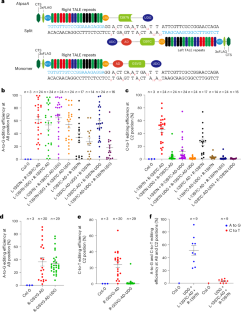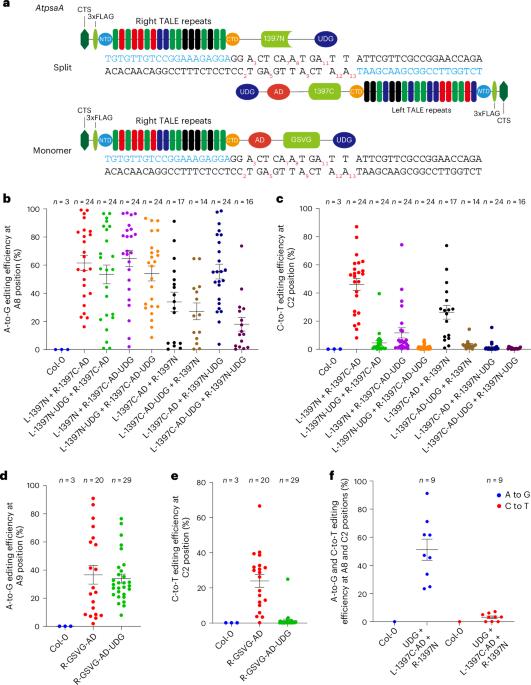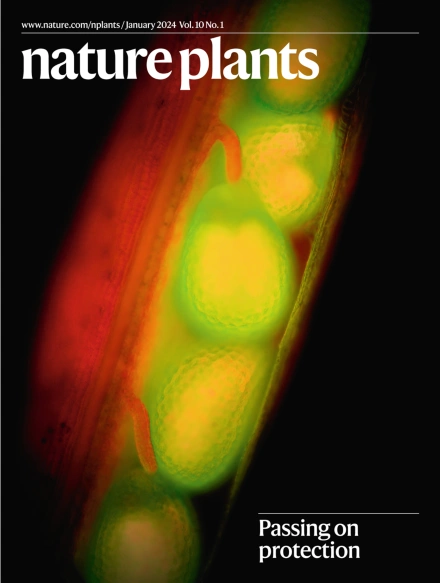Herbicide-resistant plants produced by precision adenine base editing in plastid DNA
IF 15.8
1区 生物学
Q1 PLANT SCIENCES
引用次数: 0
Abstract
CRISPR-free, protein-only cytosine base editors (CBEs) or adenine base editors, composed of DNA-binding proteins such as zinc finger proteins or transcription activator-like effectors (TALEs) and nucleobase cytosine or adenine deaminases, respectively, enable organellar DNA editing in cultured cells, animals and plants1–4. TALE-linked double-stranded DNA deaminase toxin A (DddAtox)-derived CBEs (DdCBEs) and TALE-linked adenine deaminases (TALEDs) install C-to-T and A-to-G single-nucleotide conversions, respectively, in mitochondria and chloroplasts5–9. Interestingly, whereas TALEDs exclusively induce A-to-G conversions without C-to-T conversions in mammalian mitochondrial DNA10, they often install unwanted C-to-T edits in addition to intended A-to-G edits in plastid DNA7,9,11,12. Here we show that uracil DNA glycosylase (UDG)-fused TALEDs (UDG-TALEDs) minimize C-to-T conversions without reducing the A-to-G editing efficiency and install a mutation in the chloroplast psbA gene that encodes a single-amino-acid substitution (S264G), which confers herbicide resistance in the resulting plants. Uracil DNA glycosylase-fused TALE-linked deaminases achieve precision A-to-G base editing without bystander C-to-T editing in chloroplast DNA to create herbicide-resistant plants with a heritable homoplasmic mutation in the psbA gene.


通过对质体 DNA 进行精确的腺嘌呤碱基编辑培育出抗除草剂植物
无 CRISPR 的纯蛋白质胞嘧啶碱基编辑器(CBEs)或腺嘌呤碱基编辑器分别由 DNA 结合蛋白(如锌指蛋白或转录激活剂样效应物(TALEs))和核碱基胞嘧啶或腺嘌呤脱氨酶组成,可在培养细胞、动物和植物中进行细胞器 DNA 编辑1,2,3,4。与 TALE 链接的双链 DNA 脱氨酶毒素 A(DddAtox)衍生的 CBEs(DdCBEs)和与 TALE 链接的腺嘌呤脱氨酶(TALEDs)分别在线粒体和叶绿体中进行 C 到 T 和 A 到 G 的单核苷酸转换5,6,7,8,9。有趣的是,在哺乳动物线粒体 DNA 中,TALED 只诱导 A 到 G 的转换,而不诱导 C 到 T 的转换10,但在质体 DNA 中,TALED 除了诱导预期的 A 到 G 的转换外,还经常诱导不需要的 C 到 T 的转换7,9,11,12。在这里,我们展示了尿嘧啶 DNA 糖基化酶(UDG)融合的 TALEDs(UDG-TALEDs)在不降低 A-G 编辑效率的情况下最大程度地减少了 C-T 转换,并在叶绿体 psbA 基因中安装了一个编码单氨基酸置换(S264G)的突变,从而使产生的植株具有除草剂抗性。
本文章由计算机程序翻译,如有差异,请以英文原文为准。
求助全文
约1分钟内获得全文
求助全文
来源期刊

Nature Plants
PLANT SCIENCES-
CiteScore
25.30
自引率
2.20%
发文量
196
期刊介绍:
Nature Plants is an online-only, monthly journal publishing the best research on plants — from their evolution, development, metabolism and environmental interactions to their societal significance.
 求助内容:
求助内容: 应助结果提醒方式:
应助结果提醒方式:


